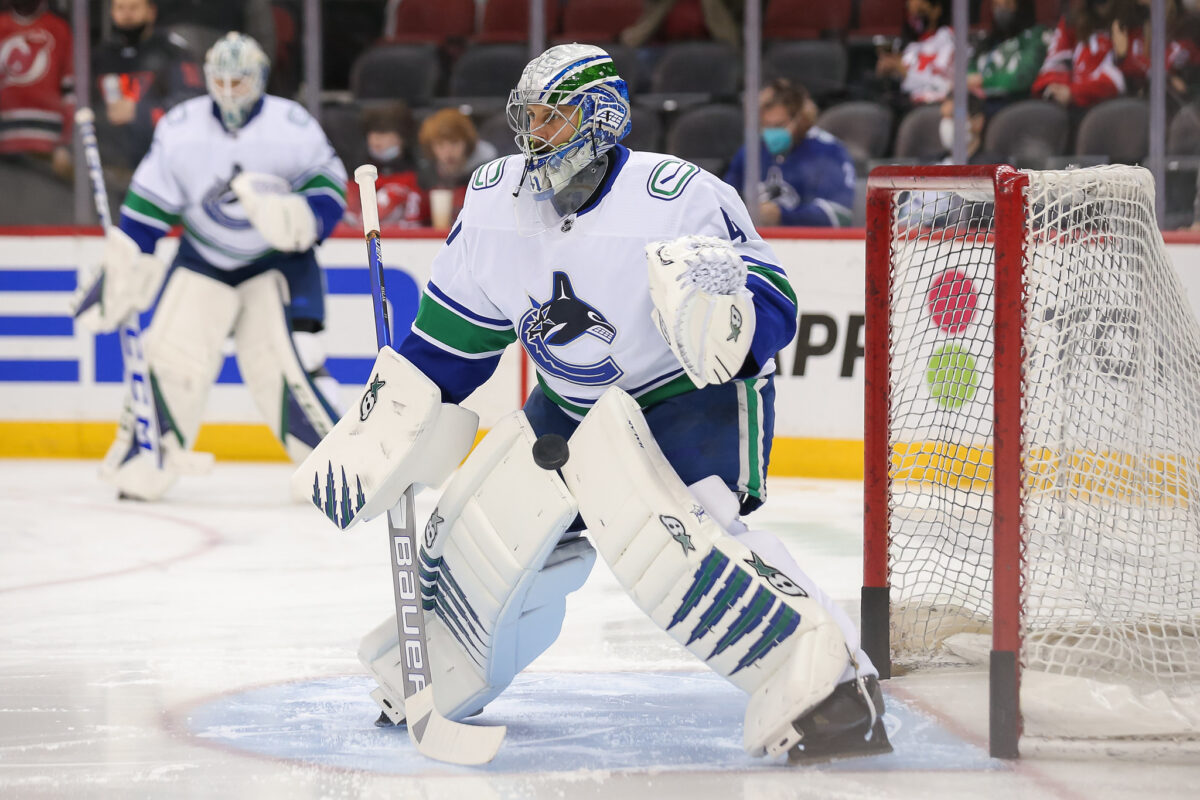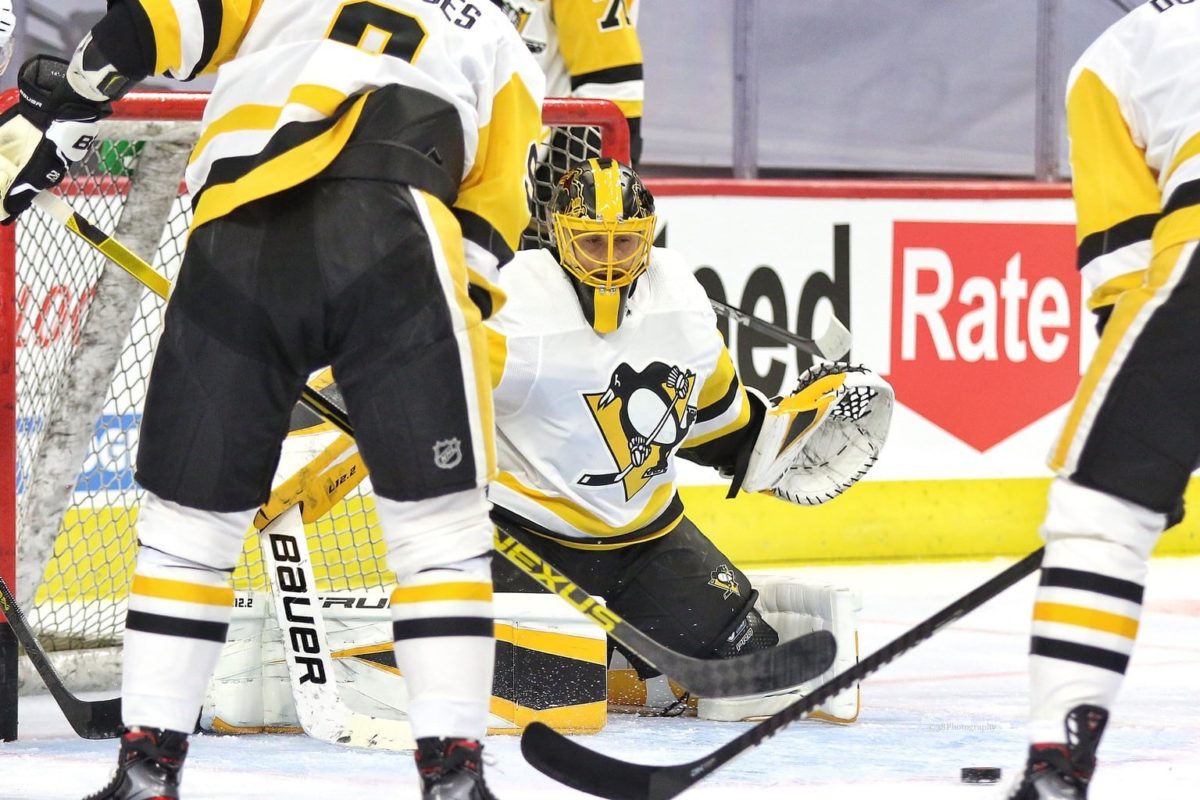Another first-round playoff elimination has the Minnesota Wild heading back to the drawing board this offseason. They have several areas that they must address, but most importantly is the goaltending situation. While Cam Talbot still has one year remaining at roughly $3.7 million, trade deadline acquisition Marc-André Fleury is an unrestricted free agent. Not to mention, Swedish goaltending prospect Jesper Wallstedt is coming over to North America for the 2022-23 season.
Needless to say, the Wild have decisions to make. Bringing back both Talbot and Fleury will be tricky with only approximately $6.5 million in cap space and six roster spots to fill. There’s a possibility Fleury will not be back, but if the Wild decide to re-sign him, Talbot could be sent packing. Plus, management might think it’s in Wallstedt’s best interest to develop in the American Hockey League (AHL) before promoting him to the NHL.
Keeping that in mind, here’s a look at three affordable backup goalies that the Wild should target in free agency this year.
1. Jaroslav Halak
If the Wild are looking for a veteran backup to play alongside Talbot or Fleury, they should look no further than Jaroslav Halak. While he isn’t the flashiest option, the two-time William M. Jennings Trophy winner brings 556 games of regular-season experience with him, along with 19 career playoff starts. That sort of experience isn’t easy to come by in this year’s free-agent class.
Related: 3 Minnesota Wild Offseason Moves That Must Be Made
Halak spent the 2021-22 season on an underachieving Vancouver Canucks team, and even though times got tough, he still managed to finish with a 4-7-2 record in 17 appearances (14 starts) with a 2.94 goals-against average (GAA) and a .903 save percentage (SV%). Although those aren’t the best numbers he’s posted, they’re not the worst. Perhaps playing for a better time like the Wild could see him bounce back this fall.

Halak might not be in his prime anymore, but he can likely play anywhere between 20 and 25 games, assuming that the Wild’s starting goaltender doesn’t get hurt. Even if he has to step up, that’s something the 37-year-old has been comfortable with in the past, proven by his stints with the Montreal Canadiens and New York Islanders.
Besides, it likely wouldn’t cost much to sign a goaltender of Halak’s age that’s near the end of his career. He was only on the books for $1.5 million last season, and it’s unlikely he sees much of an increase, if any. At that price, the Wild can’t say no, especially with general manager Bill Guerin trying to save as much money as he can. Unless Halak has no interest at all in moving to Minnesota, the Wild should at least give his agent a call before someone else does.
2. Charlie Lindgren
What better way for the Wild to get back at the St. Louis Blues for this year’s postseason elimination than to steal Charlie Lindgren from them? The 28-year-old netminder is coming off solid campaigns at both the NHL and AHL levels, making him an option worth exploring for Guerin and co.
The Blues let Lindgren take the crease five times in the regular season, resulting in a perfect 5-0-0 record. Teams had serious issues trying to solve him, proven by his 1.22 GAA and .958 SV%. Impressive as that might be, he also posted at least a .935 SV% in each of his appearances. Granted, it’s a small sample size, but goalies develop at different paces, and Lindgren may be finally ready to hit his stride.

When it comes to the AHL, Lindgren went 24-7-1 in 34 regular-season appearances, posting a 2.21 GAA, .925 SV%, and a trio of shutouts. He’s played a big role in the Springfield Thunderbirds’ playoff run, and it remains to be seen just how far he can backstop them. If he can help the Thunderbirds defeat the Chicago Wolves in the 2022 Calder Cup Final, the Wild should be even more interested in bringing him in.
One last reason why signing Lindgren makes sense is simple: he was born in Lakeville, Minnesota and attended St. Cloud State University, which is about an hour from St. Paul. The Wild have proven that they love signing local talent, and Lindgren fits that bill while also giving them an affordable backup goaltending option.
3. Casey DeSmith
I talked about Casey DeSmith in my “Wild Should Target These 3 Low-Cost Free Agents” article, but I stand by the fact that he would be a fantastic backup option for the organization next season. The Pittsburgh Penguins’ free agent played well behind Tristan Jarry this season, going 11-6-5 in 26 games (24 starts), putting up a .914 SV% and a 2.79 GAA while tying his career-high with three shutouts.
DeSmith also saved 5.5 goals above average, which is the second-best mark of his four-year NHL career. He had a .923 SV% on short-handed shots — up from .867 in 2020-21 — and only allowed 14 power-play goals against on 99 shots compared to the 11 on 69 he allowed in the previous season.

What’s great about DeSmith is that he can eat a decent number of games when needed. Whether the Wild go with Talbot or Fleury, both goaltenders are ageing and could use a backup like DeSmith, who can play 25 to 30 games in a season. He’s averaged just over 27 games in each of the last three seasons and is more than capable of stealing a win or two, proven by his 39 quality starts over that stretch.
Related: Revisiting the Minnesota Wild’s Nick Leddy Trade
Much like Halak and Lindgren, DeSmith won’t cost a fortune to sign either unless a team wants to significantly overpay. His last contract had an average annual value (AAV) of $1.25 million, which is exactly the amount of money Guerin would ideally want to spend on a backup. If DeSmith can bring the same level of play to Minnesota as he had in Pittsburgh, the Wild should be thrilled.
Why Not Wallstedt?
As mentioned earlier, there’s a decent number of Wild fans who wouldn’t mind seeing Wallstedt in the backup role next season. You can’t exactly blame them for that optimism, considering he’s been highly-touted even before he skated his way into an NHL crease. Although he might be the best goalie that the franchise has ever seen by the time his career is over, it’s important to remember one thing: he’s only 19 years old.
Starting the season in the AHL could be the best thing for Wallstedt; the Tampa Bay Lightning’s Andrei Vasilevskiy, the 19th overall pick in 2012, began his North American career during the 2014-15 season at the age of 20, spending time over his first two campaigns with the AHL’s Syracuse Crunch. Clearly, he hasn’t looked back since then.
That’s not to say that Wallstedt will immediately be the next Vasilevskiy, a Vezina Trophy winner and two-time Stanley Cup champion. It’s just to point out that there’s no sense in rushing such a rare talent, and just because Wallstedt starts in the AHL doesn’t mean he’ll be there for the entire campaign.
Wild Have Options
Cap constraints can be tricky to work with, but the Wild and Guerin are fortunate to have several affordable backup goaltending options in free agency. Halak, Lindgren, and DeSmith are all at different points in their career, but each of them can be a reliable backup for either Talbot or Fleury. There’s always the slim chance that Wallstedt wins the role during training camp, but the jury’s still out on that. Regardless, multiple options are never a bad thing, and it’ll be up to management to make the best out of the situation.
